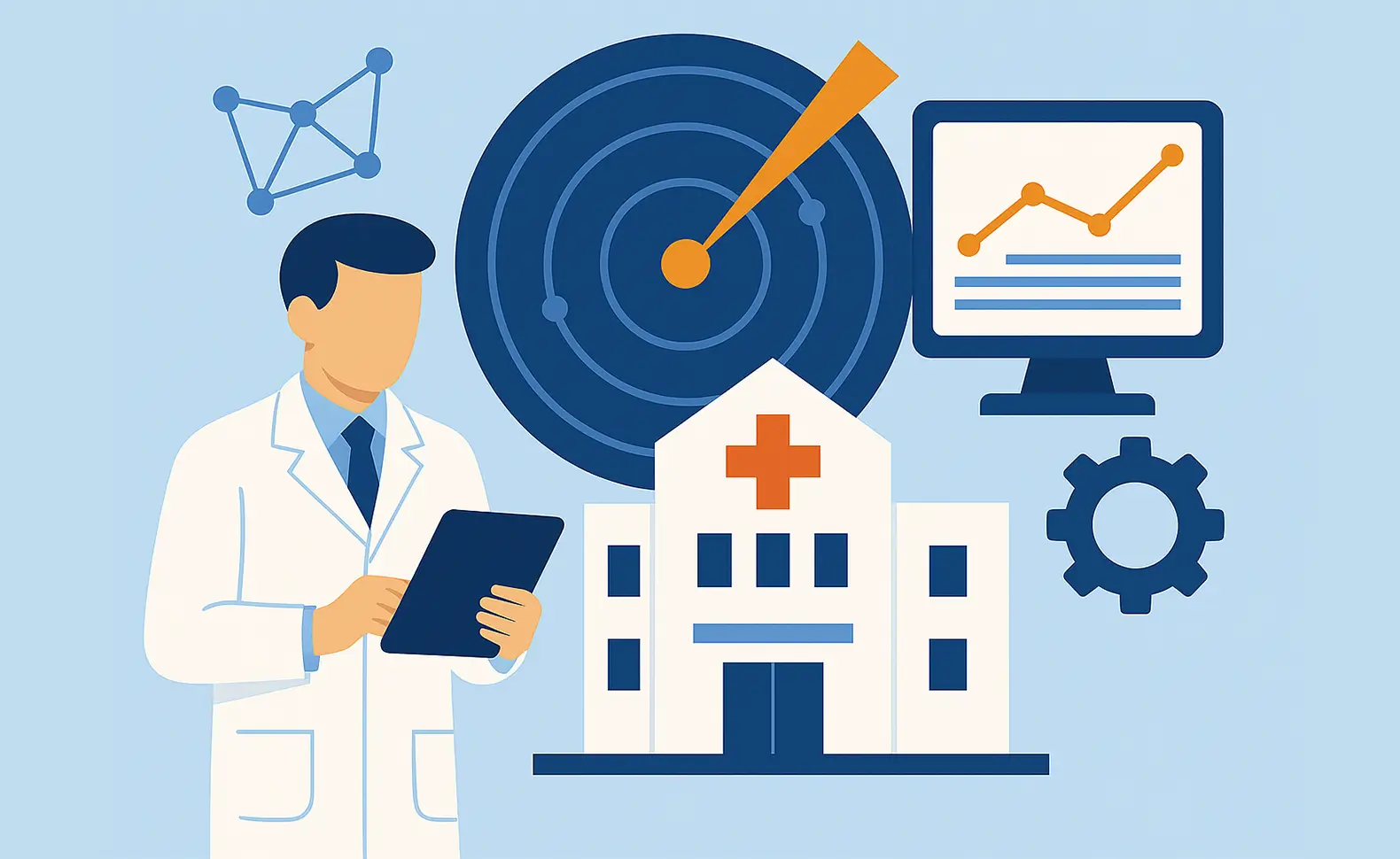The most important thing in brief:
- The digital radar hospital Is a standardized instrument for measuring digital maturity and creates a clear, comparable basis for digitization decisions.
- Hospitals benefit from a structured evaluation of your processes, IT security, interoperability and digital servicesto initiate targeted improvements.
- The analysis results help clinics to Strategically plan digitization measures and to efficiently meet legal requirements such as KHZG certificates.

What is the digital radar hospital?
The Digital radar hospital is a nationwide uniform measurement instrument that determines the digital maturity level of hospitals. The process was developed as part of Hospital Future Act (KHZG)to provide an objective overview of digitization, IT security and process quality.
The digital radar measures various dimensions — including:
- IT infrastructure & interoperability
- IT security & data protection
- Processes & procedures
- Patient Focus & Services
- Data Management & Analytics
The aim is not only to evaluate individual systems, but also to map the digital interplay of the entire hospital IT. The official information is provided by Federal Government project website.
Why is digital radar necessary?
Digitalization in healthcare is a complex undertaking — characterized by outdated structures, increasing cyber risks and increasing pressure to implement modern patient-related processes. Digital radar creates transparency that hospitals urgently need.
1. Duty to evaluate within the framework of the KHZG
As part of KHZG funding activities, hospitals must document how their digital maturity level is developing. Digital radar forms the basis for this evidence.
2. Orientation for investments
The systematic analysis provides hospital managers with a structured overview of which areas have priority — such as IT security or interoperability.
3. Increasing cybersecurity requirements
In view of the increasing number of cyber attacks on hospitals — as described in the annual BSI management report, among other things — reliable IT documentation is more important than ever.
4. Comparability
The results offer benchmarking opportunities: Where does your own hospital stand compared to similar facilities?
How is the digital radar created?
Digital radar combines several survey methods:
- Self-disclosure via questionnaires — Clinics evaluate their processes, systems and levels of maturity.
- Objective evidence — e.g. IT concepts, network plans, role and authorization concepts.
- Interviews & Reviews — the information is validated.
- Point-based evaluation — the results are presented on a scale.
For IT managers, this means: Complete IT documentation that can be accessed at any time is crucialto provide the evidence quickly and completely.
What should hospitals pay attention to when creating?
1. Complete inventory of the IT infrastructure
Many clinics still work with fragmented Excel lists or heterogeneous sources of documentation. These make it difficult to prove it against digital radar.
What is important is:
- Capture of all servers, clients, applications, and network components
- Documentation of dependencies between systems
- Overview of responsibilities
2. Transparent network and architecture plans
The digital radar also assesses the quality of technical documentation. Visual plans help auditors and clinic management understand the structure.
3. Comprehensible authorization management
In the area of IT security in particular, this plays a role Least Privilege Principle an important role.
4. Evidence for audits and tests
Digital radar requires documentable structures.
What are the benefits of Docusnap in the context of digital radar?
1. Transparent IT documentation that is always up to date
Die automatic inventory ensures that hospitals do not get stressed just before an exam. Instead, all data is available in a permanently structured manner.
2. Efficient preparation for KHZG certificates
Verification is significantly easier because the necessary information — from Network map up to Authorization concept — already available.
3. Reducing risks from cyber attacks
Many digital radar assessment dimensions require good cyber hygiene. Docusnap helps to make weak points visible.
4. Reducing the burden on the IT department
Especially in everyday hospital IT life, there is often a lack of time for documentation tasks. Automated processes significantly reduce manual effort.
5. Basis for long-term digital strategy
The digital radar only shows the status quo. Docusnap provides the data basis for planning the next steps in a meaningful way.
Digital radar 2024 and future developments
As digitization progresses, digital radar is regularly being adapted. Die 2024 digital radar results show that many clinics need to improve IT security and interoperability in particular.
Future priorities could include:
- higher cybersecurity requirements
- more focus on patient-oriented digital services
- closer integration between clinics, MVZs and practices
- stronger evaluation of structured data
For hospitals, this means: Without professional IT documentation, it will be even more difficult to meet the requirements in the future.
Conclusion: Digital radar makes you visible, Docusnap enables you to act
The hospital digital radar is an indispensable tool for making the digital maturity level of clinics measurable. But only a well-founded, automatic and continuous IT documentation makes it possible to translate the knowledge gained into concrete improvements.
Docusnap helps hospitals keep all IT-relevant information central, consistent and up to date — and thus creates the basis for successful digitization, greater IT security and sustainable development.
The next steps
If you want to improve your hospital's digital maturity level and confidently meet digital radar requirements, now is the ideal time to act. With Docusnap, you receive transparent, always up-to-date IT documentation, which relieves you of the burden of everyday hospital life and creates the basis for well-founded decisions within the framework of digital radar.
Try Docusnap now!


%20(1).webp)